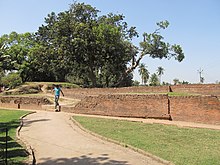 | |
| Location | West Bengal, India |
|---|---|
| Coordinates | 22°41′52″N 88°41′18″E / 22.69778°N 88.68833°E |
| Type | Settlement |
| History | |
| Founded | 400 BCE to 800 BCE |
| Abandoned | 12th century CE |
Chandraketugarh, located in the Ganges Delta, are a cluster of villages in the 24 Parganas district of West Bengal, about 35 kilometres (22 mi) north-east of Kolkata.[1][2][3] The name Chandraketugarh comes from a local legend of a medieval king of this name. This civilization can perhaps be identified with the Gangaridai of Graeco-Roman accounts. In early historic times, Chandraketugarh was connected to the Ganga by the Bidyadhari River and must have been an important centre of trade and possibly also a political centre.[4]
The Asutosh Museum of Indian Art conducted an excavation between 1957 and 1968, which revealed relics of several historical periods,[5] although the chronological classification of the relics remains incomplete. Many of the Chandraketugarh items and terracottas are now in collections of museums in India and abroad; many of them are a part of private collections.[6]
According to the List of Monuments of National Importance in West Bengal (serial no. N-WB-1), Chandraketu's Fort is an ASI listed monument.[7]
- ^ Shah, Aditi (15 July 2019). "Chandraketugarh: An Enigma in Bengal". www.livehistoryindia.com. Retrieved 1 March 2022.
- ^ "Chandraketugarh: The City That Never Was". The Indian Express. 19 February 2017. Retrieved 22 August 2022.
- ^ Dasgupta, Priyanka (7 September 2021). "Heritage panel plans int'l centre at Chandraketugarh". The Times of India. Retrieved 3 March 2022.
- ^ Singh, Upinder (2009). A History of Ancient and Early Medieval India: From the Stone Age to the 12th Century (PB). Pearson India. pp. 642–43. ISBN 978-93-325-6996-6.
- ^ Dr. Gaurishankar de & Prof. Subhradip de, Prasanga: Pratna-Prantar Chandraketugarh, First Edition: 2013, ISBN 978-93-82435-00-6
- ^ "Chandraketugarh - Banglapedia". en.banglapedia.org. Retrieved 6 March 2022.
- ^ "List of Ancient Monuments and Archaeological Sites and Remains of National Importance". West Bengal. Archaeological Survey of India. Archived from the original on 27 June 2014. Retrieved 17 April 2020.
